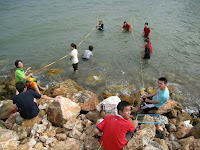On this ecology field trip, I got the chance to visit and study a Rocky Shore ecosystem off the cost of the PranBuri beach. It was a hot and very sunny day, but the sky was clear and the conditions were perfect for a field experiment.
The most abundant animal that I saw on the rocks of the shore was the barnacles (seen in the picture on the top right right). They are small marine organisms that thrive by attaching themselves to the walls of the rock. The cone shaped body structure of the barnacles and their hollow middle resembles a volcano. Due to the periodic nature of the tides, the hollow middle is an adaptation against water loss during periods of low tides. The hollow entrance is covered by valves that close to prevent water loss during dry periods. Their hard double layered shells are used as protection during high tides against the strong ocean currents.

The graph shows that there is no correlation between the two continuous belt transect. The distribution of mangrove periwinkles ( the side to the left is furthest away from the shore) varied between the two transect. In the transect represented by the pink kite diagram, the majority of the mangroves were concentrated in deeper water. The periwinkles were distributed evenly across the second transect, represented by the orange kite diagram.
The data collected for the experiment is accurate to merely a certain extent. It's difficult to try and count the number of periwinkles that are submerged in water. As they could be easily miscounted, the distribution of periwinkles along the rocky shore should be further investigated by constructing more transect along the shore to assess whether there is a correlation between the number of periwinkles and the distance from the shore.
"Seashore - A Rocky Seashore Ecosystem." :: Environmental Facts. Young Peoples Trust for the Environment, n.d. Web. 18 Nov. 2012. <http://www.ypte.org.uk/environmental/seashore-a-rocky-seashore-ecosystem/98>.

